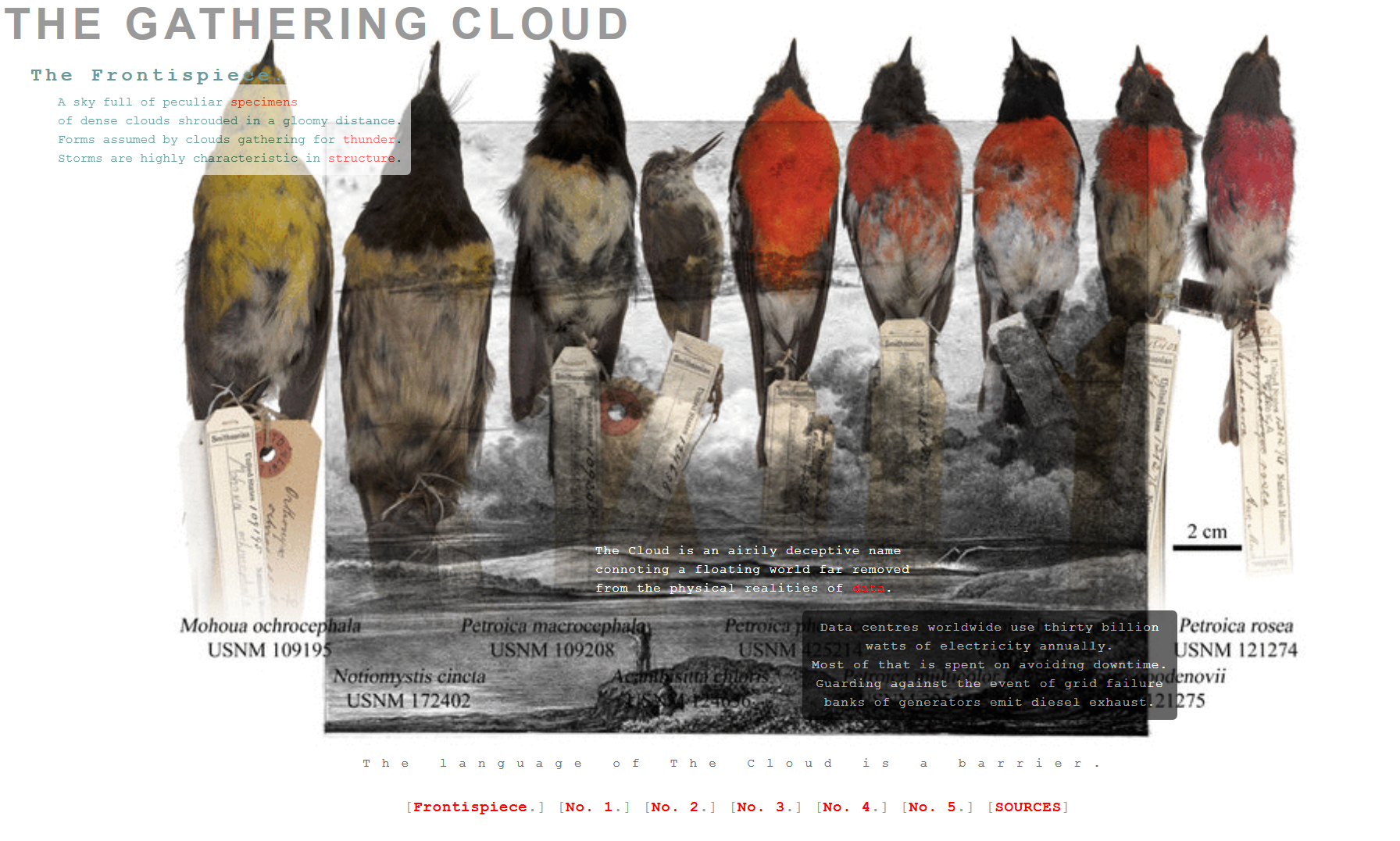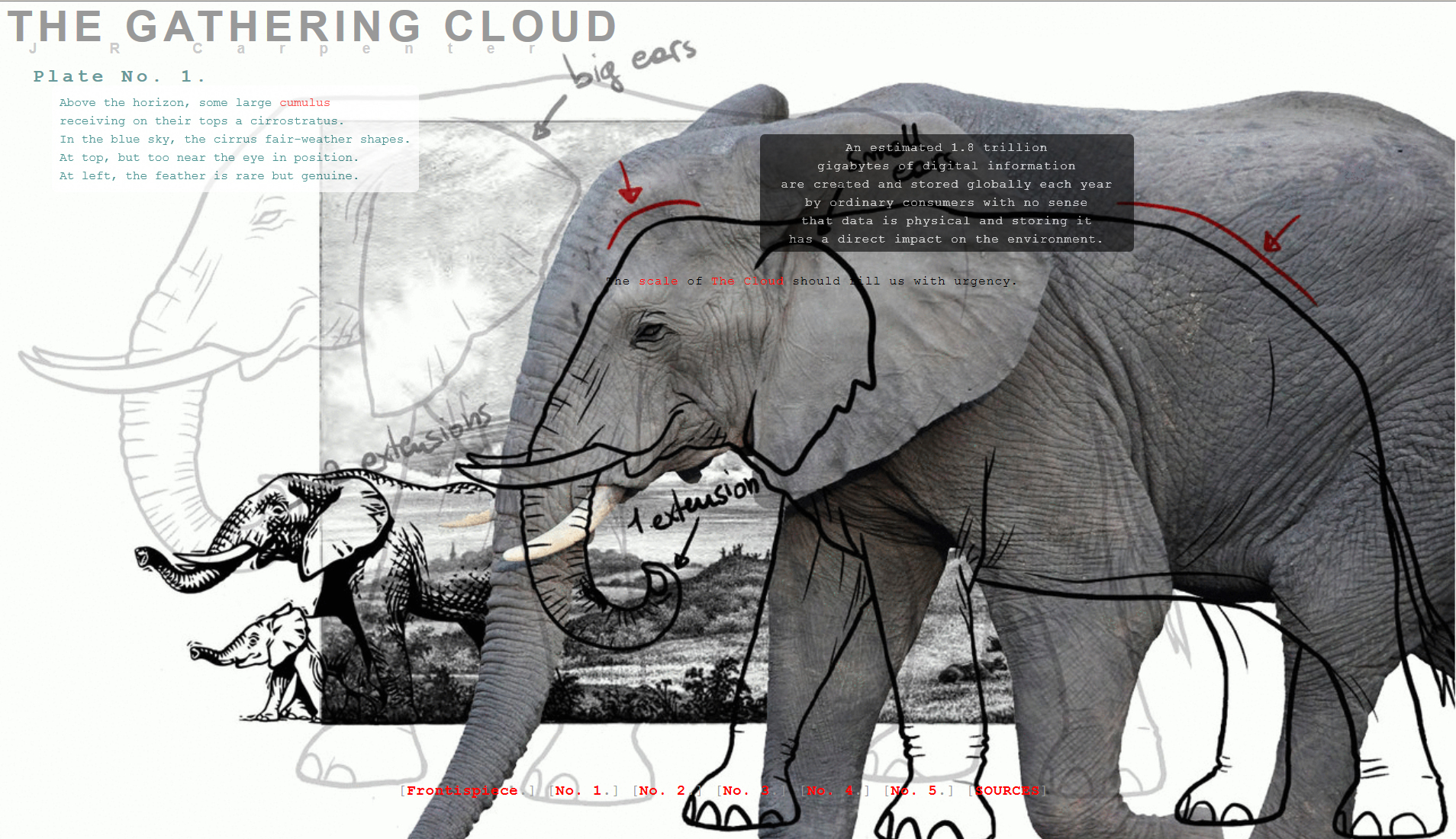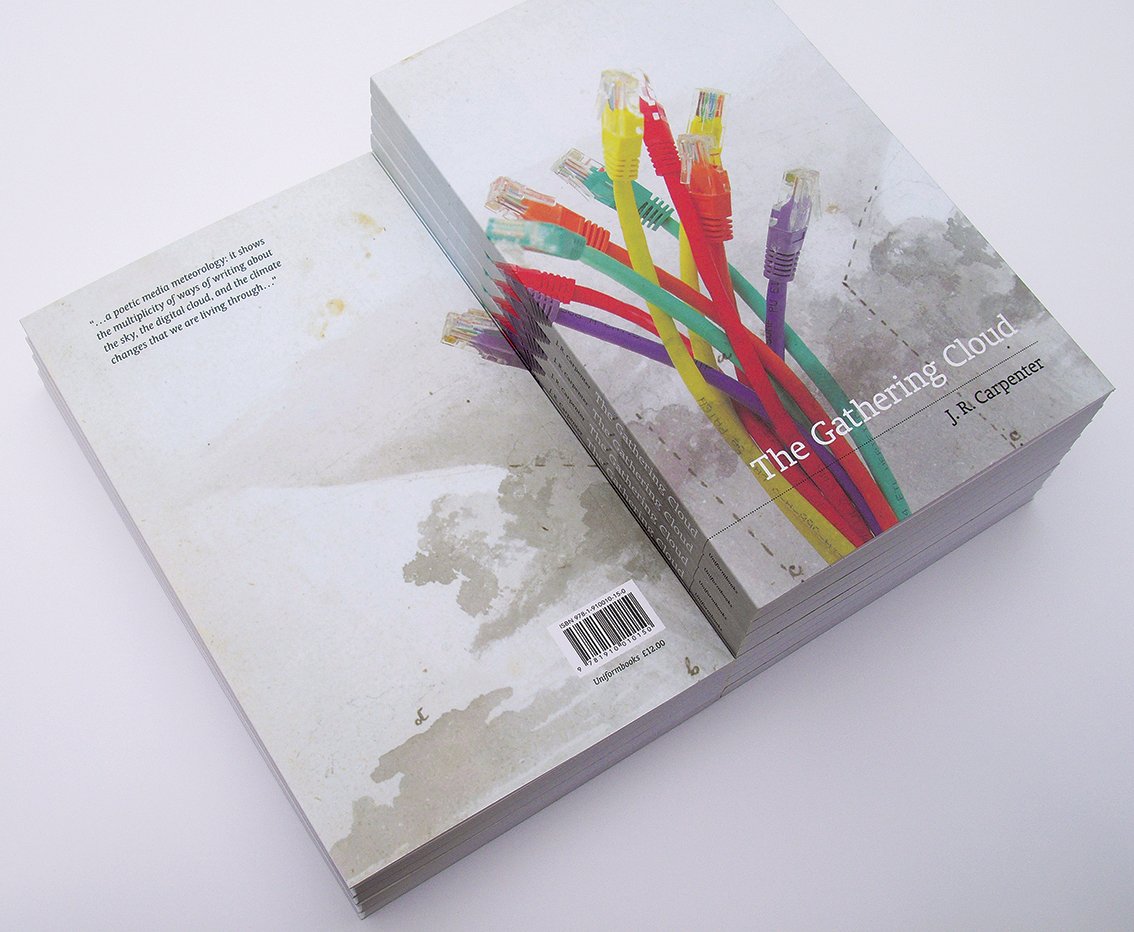



The Gathering Cloud makes slow reading. Let’s start with the title. It trips off the tongue, doesn’t it? Rolls around in the mind like a marble you’ve had since childhood. But there’s something unfamiliar about it, too. ‘The gathering cloud’ evokes a threat – the gathering crowd, perhaps; words haunted by expectation; a riot just about to begin. The gathering cloud sounds material and immaterial at the same time. It could signal rain, or warmth, or happiness for shepherds and fishermen, if only you knew how to read it. Could the ancients interpret celestial data? Can Google analysts do it now?
Every sentence in JR Carpenter’s literary artwork, The Gathering Cloud, is as resonant and expansive as its title. The work is so full of meaning, in fact, that it pushes beyond its own borders. Both a piece of digital literature commissioned by Neon Digital Arts Festival, and a book published by Uniform Press, The Gathering Cloud hovers, as an aesthetic experience, in between (it also exists as a printed A3 zine, distributed in more informal ways).
Its theme is climate change. Or, more precisely, the material effects of technologies euphemistically named ‘cloud computing’ on the health of the planet. Or the systems of knowledge that reveal and obscure our relationships to our world. Or the impossible responsibility of human actions that have a global impact. Or, in Carpenter’s characteristically succinct language in the afterword (‘Modifications on The Gathering Cloud’):
The Gathering Cloud aims to address the environmental impact of so-called ‘cloud’ computing and storage through the overtly oblique strategy of calling attention to the materiality of the clouds in the sky.
Online, The Gathering Cloud appears as a palimpsest of moving images, interacting as a series of animated gifs. To read this work is to move with it. Fragments of text respond to the hover of your mouse. Symbols march across the screen and align in multiple combinations. The experience, in other words, is just like using the internet. There is more here than you will ever be able to discover, and yet the format entices you to keep looking. The world of the browser is both (seemingly) infinite, and controlled by your gaze.

The first images you see are cloudscapes taken from Luke Howard’s Essay on the Modifications of Clouds (1803). Howard was the first person to devise a popular and scientific naming system for the clouds in the sky. His process was based on natural history classifications, Latin naming principles and the fact that clouds are subject to endless change. His project was such a success that we still use his cloud nomenclature today. But, as Carpenter points out, ‘The language of The Cloud is a barrier.’ Here, she is talking of the language of cloud computing, and how its association with the mutable territory of the sky fails to communicate its dirty, real-world effects. But the language of the clouds is also, always, a reference to Howard’s system and its structuring aim: a grand attempt to explain the (previously) unexplainable, to box in the search for knowledge, to capture what is not still there.
The illustrations that accompanied Howard’s published text were minutely detailed etchings based on his own watercolours. In the book, Carpenter describes the journey of the images as technological as well as scientific artefacts, ‘Translated into cross hatching,’ she writes,
Howard’s studies
lost subtlety, but gained fixity, moving
them toward the diagrammatic scientific.
Carpenter uses these pictures, then, to draw attention to how we understand the world as well as what we (try to) understand. Onscreen, she overlays them with photographs and illustrations of animals – elephants, birds, beetles – which echo metaphors evoked in fragments of her poetic text (‘A cloud the weight of one hundred elephants’, for example, ‘How many more birds/ have been captured and tagged and stored in The Cloud?’). Like the etchings, these animal images bear the time-stamp of specific systems of thought. Some are scientific and precise, for example, and belong, stylistically, to a process of classification: illustration as pedagogic tool.

In a final conceptual twist, each of these interwoven, visual elements has been ‘materially appropriated’ (Carpenter writes), ‘from publicly accessible cloud storage services.’ These, then, are pictures of weather clouds, and of the ways we think about weather clouds, and of the technological border patrols that control the ways we think. These are images preserved in the hardware of server farms, which means they are also images of the billow of fossil fuels, the gasp of countless lives and minerals, ground into the earth over geological time, as unimaginable in scale as the size of the data stores themselves, or the climate change precipitated by the energy they need.
Tech giants Apple, Amazon and Microsoft
power their twenty-first century clouds with
dirty nineteenth-century coal energy.
And here is the context for Carpenter’s words: lines of hendecasyllabic (eleven-syllable) verse arising inside, on top of or behind the images, borrowing and interpreting found texts from Howard’s nomenclature and contemporary media studies. All of this, finally, is the context for you: the reader/user, dragging your finger across your mouse pad as you enact the dynamic complexity The Gathering Cloud represents:
To miniscule cumulus water droplets
air is an upwelling thermal below them
is as dense as honey is to a pebble
five thousandths of a millimetre across.
As a work of digital literature, then The Gathering Cloud is an extraordinary marriage of concept and content. By which I mean literally extra-ordinary: representing and exceeding the ordinary functions of its source images and texts. While the work is hosted online, however, its rhizomatic affect has less to do with technology than with attention. In an interview in 2010 Carpenter said, ‘I imagine my target audience being people sitting at desks pretending to do other things. Like work, for example. Or writing. Because they are already pretending, their minds are wide open. [1]’ The Gathering Cloud is a lucid dream space for people not entirely in charge of their dreams.
*
The most obvious difference between the printed and online versions of The Gathering Cloud is that the book feels primarily textual. Featuring an extended prologue, the book showcases Carpenter’s writing on spacious pages, interspersed with occasional black and white ‘plates’ taken from the digital piece. Simply framed in this way, the power and precision of her words come to the fore. The hendecasyllable format produces a bare, pared down kind of language that sounds natural and restrained, like a conversation with someone who has much more to say. Describing the ancient Roman philosopher Lucretius’ theory of clouds, for example, Carpenter writes:
Nothing can be created out of nothing.
The whole earth exhales a vaporous steam.
Meaning hangs like a lifetime between these lines. The gap between ‘nothing’ and the exhalations of the earth is as big and as small as a breath being held.
Like the skeleton of a bird’s wing, each line in Carpenter’s perfectly crafted, fragile text takes the body of the work in a new direction. And yet, the most thrilling element of the book is not textual, but visual.

In print, some of the words appear greyed out. Twenty-first century readers recognise this allusion, immediately, as a hyperlink; but of course, there is nothing to click on a printed page. A book is an emblem of past decisions in a way that online experiences pretend not to be. These un-links, then, are uncanny. They promise potential, in the same moment as they fatally disappoint. They wave to the future but they are, literally, pulped emulsions of the past. They call to a space beyond the page, ripe with forbidden fruit, humming with endless desire: more knowledge, more dreaming, more distraction.
An estimated 1.8 trillion
gigabytes of digital information
are created and stored globally each year
by ordinary consumers with no sense
that data is physical and storing it
has a direct impact on the environment.
These un-links represent everything you want and everything you can’t have. They are the spaces for you to dream in and the alarm that stops you dreaming. They are the endless potential of the internet, and the finite resource that will shut it down. In other words, just as the online version of The Gathering Cloud performs the limits and aspirations of older systems of thought – the acid hatch of etchings, the earnest naivety of visual or linguistic classification – so the printed work performs the futile urgency of lives lived online. In each case, the performer on centre stage is the reader/viewer, forced to confront her own ambitions and her impotence as she navigates through mutable worlds.
This, in a nutshell, is our relationship with climate change: it is about us, but bigger than we can comprehend; we are compelled to act, but crave direction; we want to dream, but we are afraid to lose. Crucially, Carpenter asks us to inhabit this relationship, not the climate itself: her work is emotional, not didactic. Instead of explaining climate change, Carpenter explores the extent to which it can possibly be imagined. Then, gently but firmly, she pushes the borders of our thoughts, and gets us to imagine some more.
‘Like a muzzled creature’, Carpenter writes, ‘the cloud strains to be/more than it is.’ The same could be said for her work, of course, and for the people who move through it. In a perfect echo of the systems of weather and data that are its subject, different iterations of the The Gathering Cloud (whether real or imagined) are held, within the reader, as memory, as action, and as technology of thought. The Gathering Cloud could signal rain, or warmth, or happiness for idle browsers,if only you could trace your finger along each acid scratched line. Could the ancients sculpt the hubris of the searching gaze? Can the Google server farms do it now?
By Mary Paterson
Review of The Gathering Cloud, JR Carpenter
http://luckysoap.com/thegatheringcloud/
Uniform Books, 2017